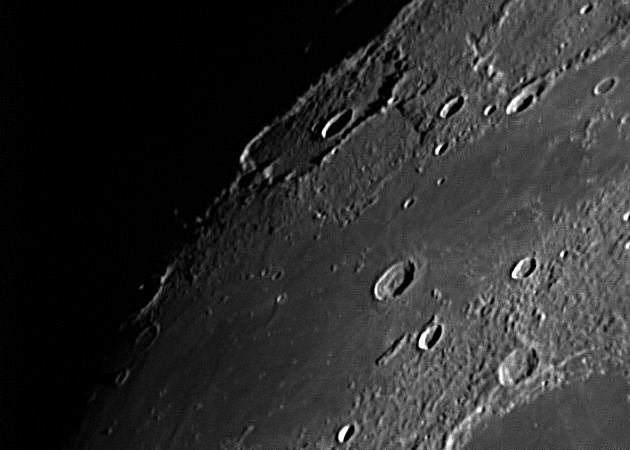Harpalus marks the division between Sinus Roris and Mare Frigoris and so breaks the long reach of mare lavas all the way from the Oceanus Procellarum, which fills much of the western side of the Moon, to the far eastern end of Mare Frigoris. Harpalus is obviously younger than the lavas and is believed to be less than 1,000 million years old. Babbage, however, is much older, at least 4,000 million years, as evidenced by the two craters within it and the general rubble which is probably ejecta from more recent impacts. South is a very interesting old crater, credited with a similar age to Babbage, but the dividing wall is actually concave to South (although this is not obvious in my picture) indicating that South is younger than Babbage. Its northern edge looks more like a cliff than a typical arc of mountains, the southern extremity appears to be missing, and the eastern side appears to fall into Mare Frigoris. The only other picture I have of this area seems to confirm this drop but is by no means clear. The floor of South is heavily cratered but seems to stop abruptly at Mare Frigoris. The mare lavas are much younger than the crater so this abrupt finish is not surprising, but where did the wall of the crater go? Lunar-orbiter pictures are, of course, much clearer than mine, but, by and large, do confirm these impressions.

|
Move your mouse over the picture to see the names of the various craters.
The markers are approximately 100 Km north and east and apply at Harpalus.
|
| Lunar Age: |
12.3 days |
| Colongitude: |
61.3° |
| Date and Time |
27th March 2010 23:20 UT. |
Camera |
DMK 21AF04. |
Telescope |
LX200 at prime focus with Astronomik OIII filter. |
Capture |
ICcapture. High gamma, 1/91", gain 856, 4163 frames. |
Processing |
Registax. 5 alignment points 380 frames stacked. Wavelet 1-2 = 10.
Focus Magic 1,100. |
Home Back to SE Quadrant


